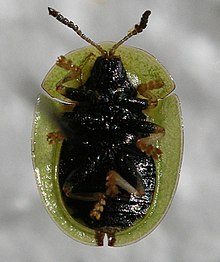Rusty shield beetle
| Rusty shield beetle | ||||||||||||
|---|---|---|---|---|---|---|---|---|---|---|---|---|

Rusty shield beetle ( Cassida vibex ) |
||||||||||||
| Systematics | ||||||||||||
|
||||||||||||
| Scientific name | ||||||||||||
| Cassida vibex | ||||||||||||
| Linnaeus , 1767 |
The rusty tortoise beetle ( Cassida vibex ) is a beetle from the leaf beetle family (Chrysomelidae). It belongs to the subfamily of the tortoise beetles , of which about 60 species are represented in Europe . In Central Europe there are around 30 species that are difficult to distinguish from one another.
features
The beetles are 5.5–7 mm long. They are short oval in shape. Pronotum and elytra are colored gold-green. The end links of the antennae are colored black. The legs are light-colored, only the femora are black with the exception of the tip. The label and the seam of the wing covers are colored reddish brown. The latter extends to the 1st rib and is interrupted by yellow spots. Between the 7th and 8th row of dots there is a red-brown spot halfway along.
distribution
The species is distributed in the Palearctic . In Europe it is widespread, its occurrence extends in the south to the Mediterranean and in the north to Scandinavia . It is widespread and common in England. To the east, the occurrence extends over Turkey (except the southeast), Central Asia and Siberia to China and Japan (Honshu, Hokkaido).
Way of life
The adult beetles can be seen from April to September. The typical habitat of the beetle species are field edges and ruderal areas . One finds the beetles often to composite flowers (Asteraceae) of the following genera: thistles ( Cirsium ), carduus ( Carduus ), burdock ( Arctium ) and knapweed ( Centaurea ). The beetles feed on the leaves from the outside, which they can skeletonize. In a study of possible biological antagonists of introduced thistle species that act as agricultural weeds, the following host spectrum was determined experimentally and according to literature: Genus Carduus : Carduus defloratus , C. crispus , C. pycnocephalus , C. tenuiflorus , C. nutans , C. personatus , also on the genera Cirsium , Centaurea , Arctium , Onopordum , Silybum , Serratula , Cnicus , Cartharnus , Cynara , Tanacetum , Xeranthemum , Echinops , Carlina , Helianthus , Chrysanthemum , Solidago , Erigeron , Aster , Taraxacum , Lactuca . A common host plant in Central Europe is the safflower .
Similar species
- Cassida bergeali - long-oval shape, thighs at the tip more extensive and brightly colored.
Taxonomy and systematics
The genus Cassida is represented in Europe with almost 60 species. The species belongs in the genus Cassida to the subgenus Cassida s. st., makes you in with the very similar species C.pannonica , C.bergeali , C.humeralis , C.fausti , C.elongata and C.inopinata the VIBEX group of species. All of the named species have the red-brown spot along the seam of the elytra in common. Some can be distinguished by the color of the thighs (femora), but the shape of the spermatheca of the females should be used for an exact species diagnosis (only possible on the prepared animal, under the microscope). Of the species mentioned, besides vibex , only bergeali and pannonica are to be expected in Central Europe. The course of the spermatheca is strongly elongated and tortuous in this species. When mating, the male pushes a long part of his mating apparatus called the flagellum into the spermatheca.
Web links
- Tortoise Beetle - Cassida vibex at www.naturespot.org.uk
- www.kerbtier.de
Individual evidence
- ^ A b Cassida (Cassida) vibex Linnaeus, 1767 in Fauna Europaea. Retrieved March 3, 2018
- ↑ a b c d e Heinz Freude, Karl Wilhelm Harde, Gustav Adolf Lohse (ed.): Die Käfer Mitteleuropas . tape 9 . Cerambycidae Chrysomelidae . Spektrum Akademischer Verlag, Munich 1999, ISBN 3-8274-0683-8 , pp. 277 (first edition: Goecke & Evers, Krefeld 1966).
- ↑ a b c d Arved Lompe: Beetles of Europe - Cassida . www.coleo-net.de. Retrieved March 3, 2018.
- ↑ a b c d e Jiři Zahradnik, Irmgard Jung, Dieter Jung et al .: Beetles of Central and Northwestern Europe: an identification book for biologists and nature lovers . Parey, Berlin 1985, ISBN 3-490-27118-1 , pp. 298 .
- ↑ DS Hubble: A review of the scarce and threatened beetles of Great Britain: The leaf beetles and their allies (Chrysomelidae, Megalopodidae and Orsodacnidae). Species Status No.19. Natural England Commissioned Report NECR161. Natural England, 2014. ISBN 978-1-78354-142-3
- ↑ Hüseyin Özdikmen & Gamze Kaya (2014): Chorotype identification fpr Turkish Chrysomeloidea (Coleoptera) part 1 - Chrysomelidae: Hispinae and Cassidinae. Munis Entomology & Zoology 9 (1): 58-70.
- ↑ Lech Borowiec (2009): New records of Asian and Australopapuan tortoise beetles (Coleoptera: Chrysomelidae: Cassidinae). Genus 20 (3): 435-484.
- ↑ Naoyuki Fujiyama, Kozue Togashi, Shogo Kikuta, Haruo Katakura (2011): Distribution and host specificity of the thistle-feeding tortoise beetle Cassida vibex (Coleoptera: Chrysomelidae) in southwestern Hokkaido, northern Japan. Entomological Science 14 (3): 271-277. doi: 10.1111 / j.1479-8298.2011.00456.x
- ↑ Batra, SWT, JR Coulson, PH Dunn, and PE Boldt. (1981): Insects and fungi associated with Carduus thistles (Compositae). US Department of Agriculture, Technical Bulletin No. 1616. 100 pp.
- ↑ Davide Sassi & Lech Borowiec (2006): Cassida inopinata, a new species from Italy and Balkan Region (Coleoptera: Chrysomelidae: Cassidinae). Genus 17 (4): 545-560.
- ↑ January Bezděk & Aleš Bezděk (1998): Cassida bergeali Bordy, 1995 (Coleoptera, Chrysomelidae) - first record for Slovakia. Entomological Problems 29 (1): 18.
- ↑ Yoko Matsumura, Jan Michels, Esther Appel, Stanislav N. Gorb (2017): Functional morphology and evolution of the hyper-elongated intromittent organ in Cassida leaf beetles (Coleoptera: Chrysomelidae: Cassidinae). Zoology 120: 1-14. doi: 10.1016 / j.zool.2016.08.001
